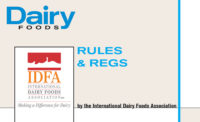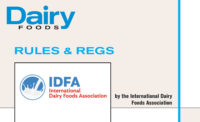The rules of engaging regulators have shifted in the Trump administration, offering new channels and increased access that create a better regulatory environment for both consumers and industry. The International Dairy Foods Association (IDFA) quickly recognized this environment as an opportunity for a new approach. We intensified ongoing efforts to gain regulatory revisions — and, in some cases, relief — with significant results.
New tone
Ten days into his presidency, President Donald Trump set a new tone by introducing Executive Order 13771. The order requires agencies to identify two regulations to repeal whenever they propose or finalize a new regulation.
Ten months into the administration, agencies agreed with the food industry’s request to delay changes required to the Nutrition Facts label, broadened milk options in schools, harmonized two major regulations for dairy plants producing Grade “A” products and even granted regulatory discretion for using ultrafiltered milk in cheese, removing a confusing obstacle for cheese manufacturers.
In this new era, IDFA is eagerly working with regulators on the issues we care about most.
Through the leadership of Michael Dykes, D.V.M., in his first year as IDFA president and CEO, we’ve started at the top with leaders at FDA, USDA and the White House.
We’re strategically tying dairy issues to a bigger picture, demonstrating how they affect not just our industry, but also our economy.
Nutrition Facts label
Earlier this year, FDA proposed extending the compliance date for changes to the Nutrition Facts label from July 26, 2018, to Jan. 1, 2020. The agency acted in response to requests from trade associations such as IDFA for more time to implement the extensive changes.
We expect USDA to issue the final bioengineered food disclosure standard by July 2018. This would mean that companies could work on both requirements at the same time, saving valuable production time and costs.
Ultrafiltered milk
For decades, FDA rules have allowed milk that was ultrafiltered (UF) at a cheese plant to be used to make cheese and labeled “milk,” while UF milk processed off-site was not permitted for many cheeses and, when it was used, had to be labeled “ultrafiltered milk.”
Trade issues with Canada this year highlighted this status of UF milk in the United States. So after nearly 20 years of asking FDA to make the regulation consistent, IDFA connected the dots for regulators, demonstrating that an update could solve a major economic issue and open domestic markets for UF milk.
In August, FDA agreed to allow regulatory discretion for the use of UF milk in all standardized cheeses without the need for special labels. The agency also confirmed its intent to permanently update the standard.
School milk
In his first week as secretary of agriculture, Sonny Perdue met with IDFA and several member representatives. We highlighted the necessity of milk options in schools to ensure children get the nutrition they need.
This May, Secretary Perdue directed USDA to allow schools to serve low-fat flavored milk. USDA followed by releasing a memo explaining how foodservice authorities can gain exemptions for the new milk options.
Secretary Perdue also announced his intent to change regulations to make low-fat flavored milk a permanent option for schools.
FSMA
This April, IDFA successfully advocated for regulations in the Pasteurized Milk Ordinance that align the National Conference on Interstate Milk Shipments program with requirements of the Food Safety Modernization Act’s (FSMA) Preventive Controls for Human Food rule. This alignment will help the industry continue to practice strong food safety procedures while avoiding contradictory regulations.
IDFA will continue to leverage this era of regulatory reform in the coming year.
For more information about what the future holds, I hope you will join other dairy leaders as we discuss these issues at Dairy Forum 2018, Jan. 21-24 in Palm Desert, Calif.




